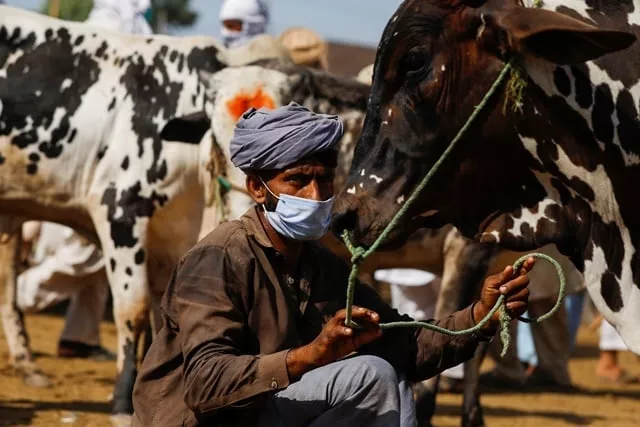Pandemic leads to rise in collective sacrifice
Over 30% more people reportedly choosing it this year
A pandemic-induced economic crisis has resulted in the public’s increased inclination towards collective sacrifice in Karachi this Eidul Azha.
Speaking to The Express Tribune, Imranul Haq, the administrator of a mosque who also volunteers at a welfare organisation, explained that the economic challenges following the pandemic had significantly reduced people’s purchasing power, leading to a rise in the trend of collective sacrifice.
He estimated that a rise of 30 per cent to 40 per cent had been observed in the trend as compared to last year, in the absence of any official data to corroborate these numbers. He went on to say that roughly 200,000 animals are slaughtered on account of collective sacrifice by madrassas, mosques and welfare organisations each year, adding, however, that with no official numbers available, the actual numbers may be greater or fewer.
Details accumulated by The Express Tribune, though, present a rough picture of the rising trend.
The Edhi Foundation will reportedly be sacrificing 4,000 animals on account of combined sacrifice, Saylani Welfare Association over 3,000, Al Mustafa Welfare Society 1,000, Chhipa Welfare Association around 1,500, Alamgir Welfare Trust International 3,000, AlKhidmat Foundation Pakistan 40,000, and Jafaria Disaster Management Cell Welfare Organisation (JDC) will also be sacrificing thousands of animals.
Joining hands
Collective sacrifice, where up to seven persons contribute for the purchase, upkeep and slaughter of a sacrificial animal, is a more economical option in comparison to each person sacrificing a single animal.
It is usually carried out through madrassas, mosques and welfare organisations, under a well-organised system. However, the coverage of their operations varies, with some welfare organisations providing services for collective sacrifice even at the regional level.
According to Haq, though, most people opt for madrassas and local mosques for collective sacrifice. These madrassas, mosques and welfare organisations distribute most of the meat among the poor and use animal hides to raise money for charitable activities, he explained.
Besides welfare organisations, madrassas and mosques, individuals on their own also often form groups of three, five or seven for collective sacrifices, mostly comprising neighbours.
A cost-effective option
Reiterating the cost-effectiveness of collective sacrifices, Haq said that various mosques, madrassas and welfare organisations had introduced a range of packages differing on the basis of cost, so that people could opt for what they could afford.
They collect a certain fixed amount - covering the cost of fodder, the animal itself, slaughter and other services - from each individual and carry out the sacrifice on their behalf.
As per details collected by The Express Tribune, the price for a share in a cow at the afore-mentioned organisations ranges from Rs8,000 to Rs13,550, while the cost of sacrificing a goat with these organisations starts at Rs12,000 and goes up to Rs18,000 - far less than these animals would cost in the market.
In case of individuals grouping on their own for the practice, the share of each person is determined after calculating all the expenses.
Haq further stated that this time around, more and more people had been registering for collective sacrifice via telephone and online through social networking sites, especially those residing abroad.
Earlier, a notification issued by the Sindh government also urged people to opt for “distant Qurbani” [distant slaughter] through a reputable and registered organisation and collective sacrifices, keeping in view the situation ensuing the coronavirus pandemic. Besides, elected representatives have also been appealing to the public for the same.
Published in The Express Tribune, July 31st, 2020.


COMMENTS
Comments are moderated and generally will be posted if they are on-topic and not abusive.
For more information, please see our Comments FAQ